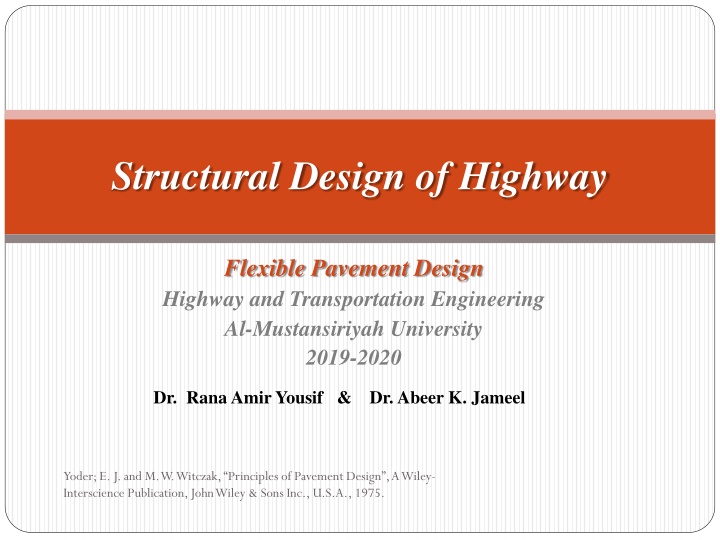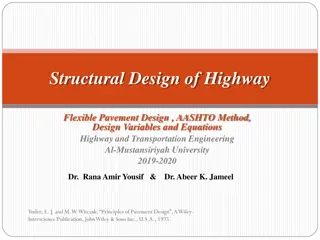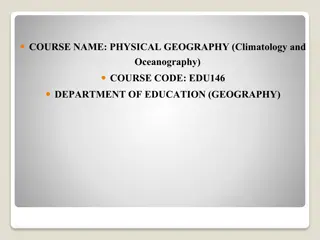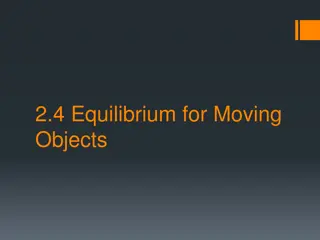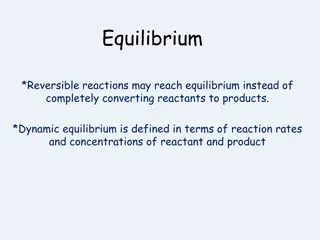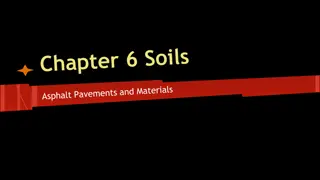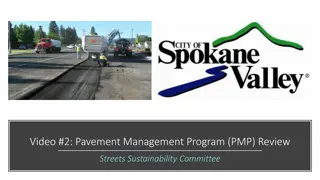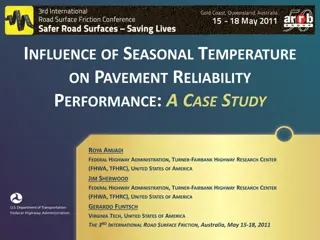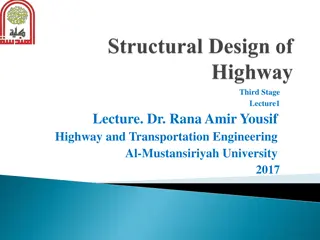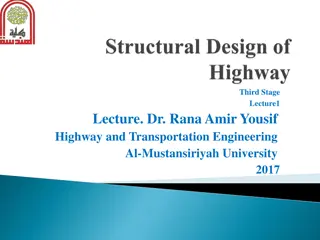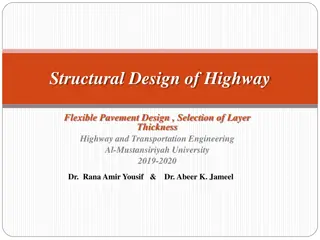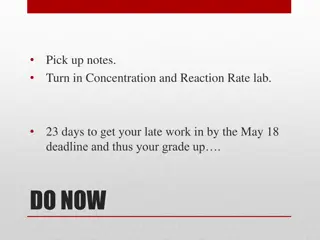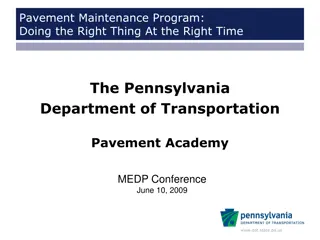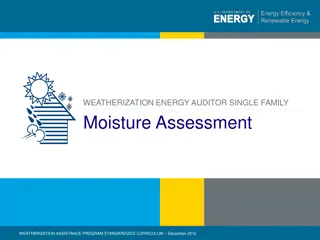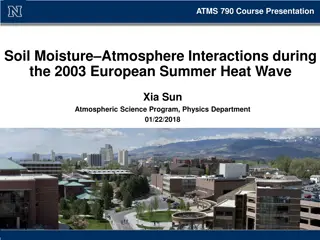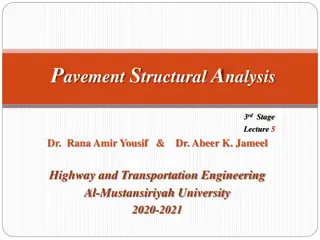Climate Models and Moisture Equilibrium in Flexible Pavement Design
Climate inputs like temperature and moisture play key roles in flexible pavement design. The heat transfer model evaluates frost action and temperature regimes, while moisture equilibrium models consider the interaction between soil suction and moisture content. Understanding these factors is crucial for designing durable and resilient flexible pavements.
Download Presentation

Please find below an Image/Link to download the presentation.
The content on the website is provided AS IS for your information and personal use only. It may not be sold, licensed, or shared on other websites without obtaining consent from the author.If you encounter any issues during the download, it is possible that the publisher has removed the file from their server.
You are allowed to download the files provided on this website for personal or commercial use, subject to the condition that they are used lawfully. All files are the property of their respective owners.
The content on the website is provided AS IS for your information and personal use only. It may not be sold, licensed, or shared on other websites without obtaining consent from the author.
E N D
Presentation Transcript
Structural Design of Highway Flexible Pavement Design Highway and Transportation Engineering Al-Mustansiriyah University 2019-2020 Dr. Rana Amir Yousif & Dr. Abeer K. Jameel Yoder; E. J. and M. W. Witczak, Principles of Pavement Design , A Wiley- Interscience Publication, John Wiley & Sons Inc., U.S.A., 1975.
References Nicholas J. Garber and Lester A. Hoel. Traffic and Highway Engineering , Fourth Edition. Yoder; E. J. and M. W. Witczak, Principles of Pavement Design , A Wiley- Interscience Publication, John Wiley & Sons Inc., U.S.A., 1975. Yaug H. Huang, Pavement Analysis and Design , Prentic Hall Inc., U.S.A., 1993. AASHTO Guide for Design of Pavement Structures 1993 , AASHTO, American Association of State Highway and Transportation Officials, U.S.A., 1993. Oglesby Clarkson H., Highway Engineering , John Wiley & Sons Inc., U.S.A., 1975. Yoder; E. J. and M. W. Witczak, Principles of Pavement Design , A Wiley- Interscience Publication, John Wiley & Sons Inc., U.S.A., 1975.
CHAPTER 11 Flexible Pavement Design Climate Models Temperature and moisture are significant climatic inputs for pavement design. The modulus of the HMA depends on pavement temperature; the moduli of the base, subbase, and subgrade vary appreciably with moisture content. Heat Transfer Model The heat transfer model was originally developed at the University of Illinois (Dempsey and Thompson, 1970) for evaluating frost action and temperature regime in multilayered pavement systems. The model applies the finite difference method to solve the following Fourier equation for one-dimensional heat flow: Here, T is the temperature, t is the time, z is the depth below surface, and a is the thermal diffusivity, which is related to the thermal conductivity and heat capacity of the pavement materials. Given the initial temperature distribution and the two boundary conditions (at the pavement surface and at a depth H below the surface), Eq.11.1 can be solved. Yoder; E. J. and M. W. Witczak, Principles of Pavement Design , A Wiley- Interscience Publication, John Wiley & Sons Inc., U.S.A., 1975.
Flexible Pavement Design Moisture Equilibrium Model Moisture Equilibrium Model The moisture equilibrium model in the CMS model (Dempsey et al., 1986) is based on the assumption that the subgrade cannot receive moisture by infiltration through the pavement. Any rainwater will drain out quickly through the drainage layer to the side ditch or longitudinal drain, so the only water in the sub-grade is the capillary water caused by the water table. Because of the thermodynamic relationship between soil suction and moisture content, a simple way to determine the moisture content in a soil is to determine its suction, which is related to the pore water pressure. Figure 11.2 shows the suction moisture curves for five different soils with varying clay contents, as indicated by the numerals in parentheses under each soil title. These curves were obtained in the laboratory by drying tests, in which different levels of vacuum or suction were applied to a wet soil specimen until the moisture was reduced to an equilibrium value. The suction is expressed in the pF scale, which is the logarithm of water tension in cm, as defined by Schofield (1935) . The corresponding values in terms of psi are shown on the left scale. It can be seen that suction increases as the moisture content decreases or the clay content increases. The increase in suction is due to the soil particles. In the CMS model, empirical relationships were used to define the suction moisture curve based on the liquid limit, the plasticity index, and the saturated moisture content of the soil. When there is no loading or overburden pressure, suction is equal to the negative pore pressure. When a load or overburden is applied to an unsaturated soil with given moisture content or suction, the suction or moisture content remains the same but the pore pressure becomes less negative. The relationship between suction and pore pressure can be expressed as: Yoder; E. J. and M. W. Witczak, Principles of Pavement Design , A Wiley- Interscience Publication, John Wiley & Sons Inc., U.S.A., 1975.
Flexible Pavement Design Moisture Equilibrium Model in which uis the pore pressure when soil is loaded ; Sis the soil suction, which is a negative pressure ; pis the applied pressure (or overburden), which is always positive ; and ais the compressibility factor, varying from 0 for unsaturated, cohesionless soils to 1 for saturated soils . For unsaturated cohesive soils, a is related to the plasticity index PI by (Black and Croney, 1957) The pore pressure in a soil depends solely on its distance above the ground-water table: Yoder; E. J. and M. W. Witczak, Principles of Pavement Design , A Wiley- Interscience Publication, John Wiley & Sons Inc., U.S.A., 1975.
Flexible Pavement Design Moisture Equilibrium Model Here, zis the distance above the water table, and is the unit weight of water. This simple fact can be explained by considering soils as a bundle of capillary tubes with varying sizes. Water will rise in each of these capillary tubes to an elevation that depends on the size of the tube. At any distance z above the water table, a large number of menisci will form at the air water interfaces, causing a tension at each elevation corresponding to the height of capillary rise. Combining Eqs. 11 .2 and 11 .4 yield s Yoder; E. J. and M. W. Witczak, Principles of Pavement Design , A Wiley- Interscience Publication, John Wiley & Sons Inc., U.S.A., 1975.
Flexible Pavement Design Moisture Equilibrium Model The procedures for determining the equilibrium moisture content at any point in a pavement system can be summarized as follows: 1. Determine the distance z from the point to the water table. 2. Determine the loading or overburden pressure p. 3. Determine the compressibility factor from Eq .11.3. 4. Determine the suction S from Eq .11.5. 5. Determine the moisture content from the suction moisture curve. Yoder; E. J. and M. W. Witczak, Principles of Pavement Design , A Wiley- Interscience Publication, John Wiley & Sons Inc., U.S.A., 1975.
Flexible Pavement Design Moisture Equilibrium Model Step 2: The intersection point of the horizontal line and the soil type curve Step 1: draw line from the soil from eq.11.5 suction Step 3: draw line from The intersection point of the horizontal line and the soil type curve Yoder; E. J. and M. W. Witczak, Principles of Pavement Design , A Wiley- Interscience Publication, John Wiley & Sons Inc., U.S.A., 1975.
Flexible Pavement Design Moisture Equilibrium Model Example 11.1: Figure 11.3 shows an 8-in . (203-mm) full-depth asphalt pavement on a subgrade composed of two different materials. The top 16 in . (406 mm) of subgrade is a Culham sand ; below it is a Norton clay with a PI of 18 . The relationship between the suction and moisture content of these two soils is shown in Figure 11.2 . The water table is located 12 in . (305 mm) below the top of the clay. The unit weight y of each material is shown in the figure . Predict the moisture contents at point A on top of the clay, point B at the bottom of the sand layer, and point C on top of the sand layer . Yoder; E. J. and M. W. Witczak, Principles of Pavement Design , A Wiley- Interscience Publication, John Wiley & Sons Inc., U.S.A., 1975.
Flexible Pavement Design Moisture Equilibrium Model Solution : At point A, the overburden pressure p = (8 145 + 16 120)/12 = 256 .7 psf. From Eq. 11 .3, = 0 .03 * 18 = 0 .54. From Eq. 11 .5, S = -1 * 62 .4 0 .54 * 256 .7 = -201.0 psf = -1 .40 psi. From Figure 11 .2, the moisture content is Step 1: S value 38% Yoder; E. J. and M. W. Witczak, Principles of Pavement Design , A Wiley- Interscience Publication, John Wiley & Sons Inc., U.S.A., 1975.
Flexible Pavement Design Moisture Equilibrium Model Solution : At point B, = 0 and, from Eq. 11 .5, S = -62.4 psf = -0 .43 psi. From Figure 11 .2, the moisture content is. Step 1: S value 21% Yoder; E. J. and M. W. Witczak, Principles of Pavement Design , A Wiley- Interscience Publication, John Wiley & Sons Inc., U.S.A., 1975.
Flexible Pavement Design Moisture Equilibrium Model Solution : At point C, from Eq. 11 .5, S = (12 + 16) 62.4/12 = -145.6 psf = 1 .01 psi . From Figure 11 .2, the moisture content is Step 1: S value 19.5% Yoder; E. J. and M. W. Witczak, Principles of Pavement Design , A Wiley- Interscience Publication, John Wiley & Sons Inc., U.S.A., 1975.
Structural Design of Highway Dr. Rana Amir Yousif & Dr. Abeer K. Jameel Yoder; E. J. and M. W. Witczak, Principles of Pavement Design , A Wiley- Interscience Publication, John Wiley & Sons Inc., U.S.A., 1975.
